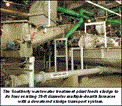Cleveland's Southerly WWTP Replaces Old Belt Conveyors with New Transport System

The new system, designed by consulting engineer firm Montgomery Watson, was progressively installed and commissioned in 1998, with concurrent demolition of an existing belt conveyance system.
 Dewatered, thermally conditioned sludge from the discharge of six centrifuges is fed to inclined dewatering screws which are coupled to singular reversing cross-over screws, which provides maximum transport crossover capability and maintenance redundancy.
Dewatered, thermally conditioned sludge from the discharge of six centrifuges is fed to inclined dewatering screws which are coupled to singular reversing cross-over screws, which provides maximum transport crossover capability and maintenance redundancy.
Sludge collected from the crossover screws is transported by two 24-in. diameter, 42 t/h, 100 hp transport collector screws which discharge into two 1450 cu.ft surge bins fitted with variable-frequency, speed-controlled live bottom discharge screws. Sludge from these surge bins can then be routed into two separate conveyance trains, again providing maximum maintenance equipment redundancy through to either truck load-out or incineration.

The authority installed a system supplied by N/A, of Markham, Ontario. It constitutes a diverse use of application-specific shafted screw conveyors, which encompass inclined dewatering, horizontal, vertical and live bottom bins inclusive of metering weigh belt conveyors. The system technologies offered by the supplier were combined on this project to offer a complete single-source supply.
Each conveyance train has a rated capacity of 15 wet t/h of thermally conditioned sludge at 45% to 50% TDS and includes inclined dewatering, VFD controlled live bottom bin, horizontal and vertical screw conveyors, as well as specialized, splitting, sealing and high-temperature incinerator feed screws.
Edited by Tracy Fabre
